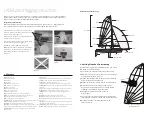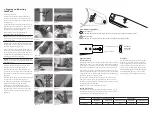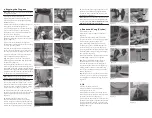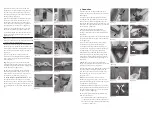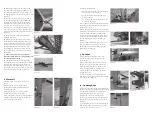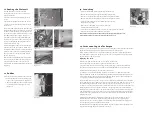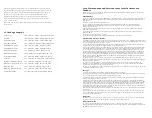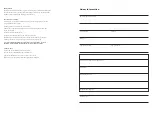
9.
Reboarding can be undertaken over the windward side of the boat using
the righting line as a step or over the transom. A grab rail is positioned on the
inner face of the sub deck to assist with pulling yourself back in to the boat.
10.
If the person in charge of the boat or the crew are inexperienced in
capsizing and righting procedures it is advised to practice drills under
skilled supervision and in any event, close to assistance prior to the drill
being used in earnest.
11.
All crewmembers should wear an approved buoyancy aid at all times while
on the water.
Laser 2000
1 x 6.0 meters, 8 mm, 8 plait, matt, white
Jib sheet
1 x 6.6 meters, 8 mm, 8 plait, matt, white
Gennaker sheet
1 x 9.0 meters, 6 mm, 8 plait matt, blue
Mainsheet Bridle
1 x 2.2 meters, 4 mm, Excel Racing, purple
Cunningham Part 1
1 x 5.0 meters, 4 mm, 8 plait p/s, lime
Cunningham Part 2
1 x 0.8 meters, 4 mm, 8 plait p/s, lime
Kicker/Vang Part 1
1 x 5.5 meters, 4 mm, 8 plait p/s, red
Kicker/Vang Part 2
1 x 2.5 meters, 5 mm, Excel Racing, red
Toestrap Lashing
4 x 0.6 meters, 6 mm, 8 plait p/s, black
Lashing
3 x 0.2 meters, 1 x 0.8 meters, 8 plait, white
Rear Toe-strap Shock-cord
1 x 0.3 meters, 5 mm, Shock cord, blue
Main Toe-strap Shock-cord
1 x 2.0 meters, 5 mm, Shock cord, blue
Righting Line
2 x 1.5 meters, 4 mm, 8 plait p/s, red
Righting Line Shockcord
2 x 0.9 meters, 5 mm, Shock cord, blue
Centerboard Line
1 x 0.75 meters, 8 mm, 8 plait p/s, white
16. Cordage Lengths
Care, Maintenance and Service of your LaserPerformance
Product
Before rigging your boat, read and familiarize yourself with the rigging manual. Failure to adhere to these guide-
lines could invalidate your warranty.
Maintenance
• Keep the equipment clean by frequently fl ushing with fresh water. In corrosive atmospheres, stainless parts may
show discoloration/brown staining around screw holes and rivets. Th
is is not serious and can be removed with
a fi ne abrasive.
• Excess water should be removed from the hull.
• Ropes, rigging and fi ttings should be checked at regular intervals for wear and tear, including winch gear.
• All moving parts should be lightly lubricated to avoid jamming, i.e., McLube, dry Tefl on or a dry silicone
based spray. Do not use oil.
• Inspect shackles, pins and clevis rings and tape up to stop snagging sails, ropes and clothing and to prevent
them from coming undone.
• When refastening screws do not over tighten as this may strip the thread and do not reuse Nyloc nuts more
than three times.
• Damaged or worn parts should be replaced.
• Sails should be thoroughly washed down with fresh water, dried and stored in a dry place.
Trailers and Trolleys/Dollies
• It is highly recommended that a trolley/dolly is used to launch and recover your boat. Dragging your hull up onto a
beach or slip way will wear away the gel coat or polyethylene and damage the boat. Also, the hull should not be left
on a pebble beach as the hull skin could be dented.
• Trailers should be rinsed with fresh water and checked at regular intervals. It is recommended that trailers be
serviced annually. Th
e trailer and road base should never be immersed in water.
• Trailers and trolleys supplied by LaserPerformance are designed to transport the hull in the best possible manner
to avoid damaging the hull. For instance, LaserPerformance does not recommend support hulls on rollers except
on the keel line and only where there is a reinforced keelson. We also recommend gunwale hung trolleys for our
smaller products. Hulls supported by a trolley bunk or wide strap must have the ability to drain water away from
the hull. Trolley bunks padded with carpet or foam can cause blistering in the gel coat and changes to the hull
color. Please do not transport your LaserPerformance product on a trailer or trolley that has not been specifi cally
designed for the product. Hulls damaged through using an incorrectly designed or wrongly set up trailer or trolley
are not covered under warranty.
• When securing your boat to a trailer for transport be very careful that ratchet straps and ropes are not over
tightened and that there is suffi
cient padding under the strap or rope to prevent the hull/deck from being damaged
through abrasion or pressure.
• Top covers must not be allowed to “fl ap” when driving at speed. Th
is can abrade the surface of the hull and
damage it. It is recommended if you are towing and plan to use your top cover that an under cover is fi tted fi rst
to prevent cover fl ap damage to the top sides of the hull.
• Repairs to the polyethylene or GRP hulls should be undertaken by persons with the relevant equipment and skills.
Contact LaserPerformance for advice.
Storage
• Your boat should always be tied down securely to the ground when not in use.
• UV light will cause fading to some components and fi ttings. A cover is recommended to reduce the UV degradation.
• Do not leave the rig under tension when not sailing or during storage.
• Care must be taken to support the hull adequately if storing on racking or similar. Any sustained point loading
could permanently dent or distort the hull.
• Under covers for LaserPerformance products should be produced from a breathable or semi breathable fabric to
allow moisture to evaporate away from the hull. Th
is is essential to prevent damage to the hull skin. Also, the hull
should never be left in the under cover wet or damp. A combination of moisture and heat over an extended period
can also damage the hull. Th
e under cover is designed to protect the hull when being transported and should be
removed when the hull is being stored. Typical damage includes small bubbles or blisters, excessive print through
of glass reinforcement, foam or wood and color change.
• Rudders and centerboards must never be stored wet in carry/combo bags. Th
is can cause blistering, print through
and warpage.
• All our GRP products are designed to be dry sailed. In other words stored on dry land. If you intend to leave your
boat on a mooring for any length of time it is essential that you apply an osmosis barrier coat. LaserPerformance
can recommend a suitable product.
On Water
• When wearing a trapeze harness, take particular care when climbing on to the centerboard and back into the
boat after a capsize. Th
e trapeze harness hook could easily damage the hull or deck.
On Water Towing
• Towing your LaserPerformance product at high speed (10 – 20 knots) behind a rib or power boat can seriously
damage the hull. Boats damaged in this manner are not covered by the warranty. LaserPerformance recommends
a maximum towing speed of 6 knots.


